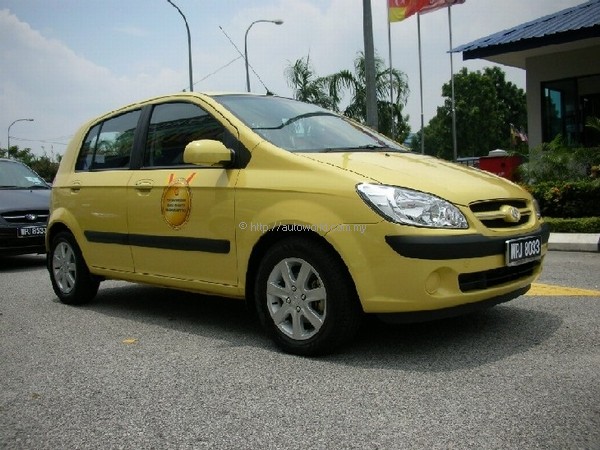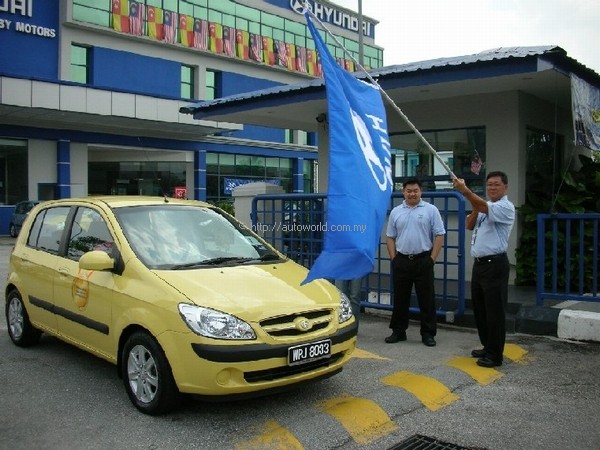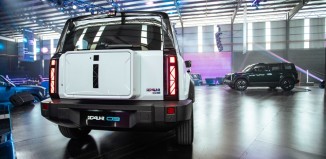New Hyundai Getz 1.4 – More power, but still delivering outstanding fuel economy
Hyundai-Sime Darby Motors Sdn Bhd launched its latest version of the Hyundai Getz in a novel way, by organizing a mini fuel economy run for the media recently. Made under the Inokom brand name, the latest Getz features a 1.4 litre, 16-valve, DOHC fuel injected engine, is now locally assembled, and carries a price reduction of more than RM10,000 compared to the hitherto fully imported version. Engine power is 97 PS at 6,000 rpm, and maximum torque is 12.8 kg.m at 3,200 rpm.
Drive to the wheels is through the front axle, by way of a 4-speed automatic gearbox, with a final ratio of 4.041 or 4.381, depending on your luck (there are two specifications, and no explanation was given at the brief; the higher number would give one better acceleration, but poorer fuel consumption, and vice versa for the lower number.) Why this is so, no one knows. The 4th gear ratio is 0.685:1, which does make the Getz ‘long-legged’, and will contribute towards the overall fuel economy too. The new Getz also comes with ventilated front disc brakes, rear disc brakes, ABS and electronic brake force distribution, and a SRS airbag for the driver.
The front suspension is made up of independent Macpherson struts, and a torsion beam axle at the rear, consistent with cars of this size and price. Shod on 14-inch wheels, with 165/65 R 14 tyres, the Getz handles quite well. Size-wise, it is classified as a ‘super-mini’, and is basically a hatchback with a length of 3,825mm, an overall width of 1,665mman overall height of 1,490mm. Wheelbase is relatively long, at 2,455mm, on account of the wheels being placed at the four extremes of the car.
From the outside, the Getz looks pretty much like the older version, save for a new front grill. It still looks cute and is a practical car for small families, or yuppies on the move. Its size makes it very practical for city use, and the occasional outstation trip.
The interior has enough room for four adults, and five if you don’t mind a little bit of a squeeze; legroom is pretty good if you are not too tall, but the price is a very small boot. If you require more space, the rear seats do split and fold down to give additional storage.
The issue of the day being the price of fuel, Hyundai-Sime Darby Motors had us take ten units on an economy challenge covering a little over 140 kilometres of mostly highway driving to see which team of two media could return the best fuel economy, using the full tank to full tank method.
Using a set of very rough ‘tulips’ as a guide, we set out on our mission. My team mate was Mr. BH Chan from the Chinese motor magazine, Motokar. We were not exactly the lightest people in the world, and in order to make up for the weight deficit, we ran with the air-conditioner off, coasting whenever and wherever we could. The trick is of course to be very gentle on the throttle, and keeping the engine speed below 2,000 rpm, being careful all the time not to allow the automatic gearbox to kick down to third or lower. In the spirit of the competition, we did all of that, even trying to time our arrival at traffic lights so that we did not have to stop or brake, but of course in the Klang Valley traffic on a Saturday afternoon, it was quite impossible to achieve this all the time.
We had to maintain an average speed of 46 kilometres per hour in order to make it back in the three hours allocated, and with traffic lights and stop and start traffic, we had to speed up as high as 90 kilometres per hour in order to maintain the average speed. It was then that we found that many other people must also be on economy drives, because we actually found that there were many other cars that were going even slower than we were.
In the end, we managed to get a fuel consumption of RM13.88 sen for the run. This works out to be 5.2 litres per 100 kilometres, or in the good old system, 54.29 miles per gallon. Mind you, this is with very hard work and concentration, and without air-conditioning; in real life, the actual fuel consumption is likely to be a little bit more, depending on how heavy your foot is, and whether you are in the habit of waiting in the car with your engine running and air-conditioner on while your loved one is at the kuey teow stall buying food. Incidentally, we did not win, as there was another media member who used only RM13.19 sen. Looks like I am not cut out for economy runs.
Overall, I think the Getz economy test is a good indicator of the potential fuel economy of small cars such as the Getz. Without a doubt, the smaller cars do use less fuel; it is basically a function of power to weight ratios, engine efficiency, the absolute weight of the vehicle and passengers, and of course, driving habits. The lighter the load, the more economical you are likely to be, and the light-footed shall rule. In real world conditions, it would be difficult for people who are rushing about in their daily rituals of trying to get to work on time, not to mention the traffic jams and the stop-start traffic, but you can still get some decent figures, as long as you don’t floor the throttle heavily all the time.


























